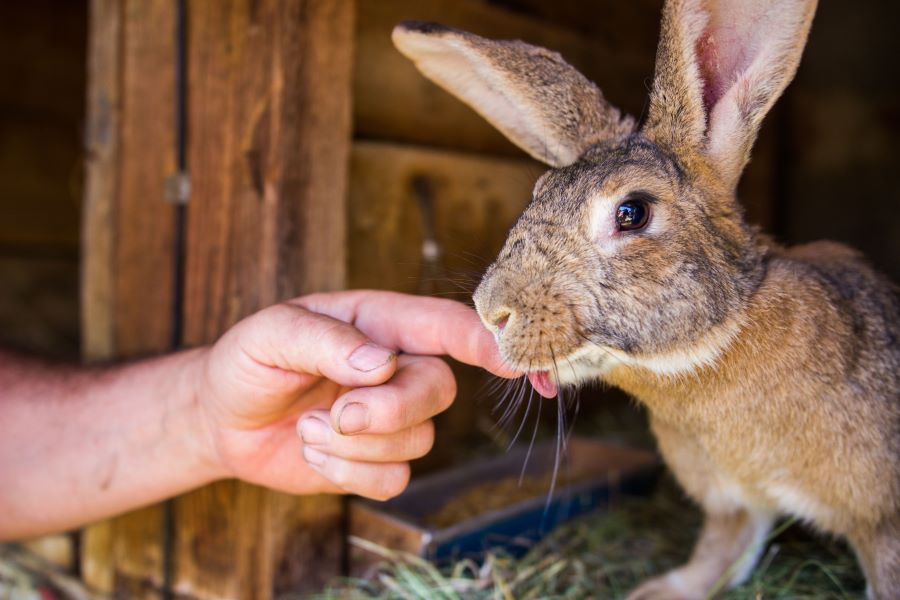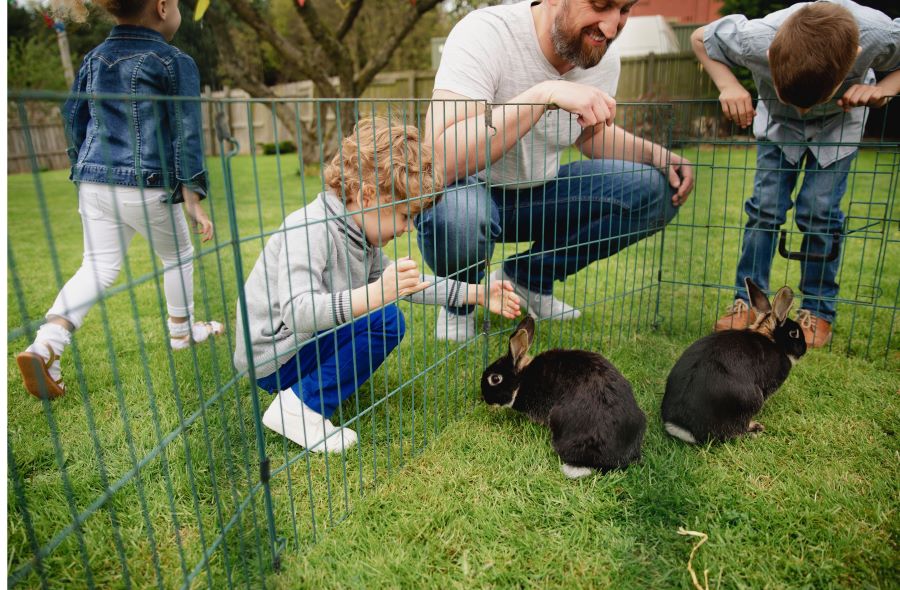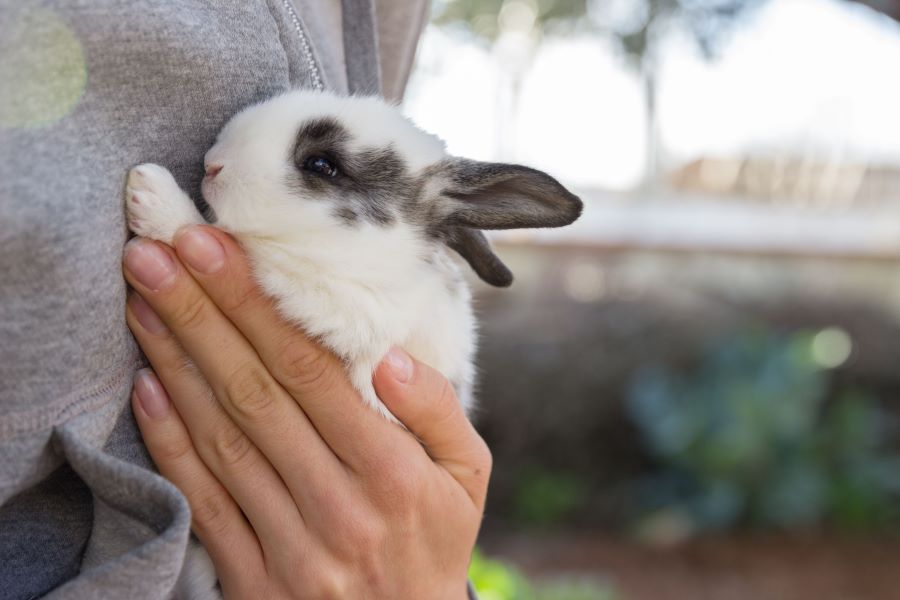Some of the posts on Mercury Pets contain affiliate links to products. That means if you click on that link and then make a purchase, we receive a percentage of the sale. We only recommend products we’ve used and support, and there’s no additional cost to you — the money goes right back into making this site the best it can be! Thanks for reading.

Many people fear losing limbs to alligators in the swamp and sharks in the ocean, but I don’t hear of many people having nightmares of their bunny biting off their hand. I mean is it even possible? Can a rabbit bite your finger off?
Although highly unusual, it is technically possible for your bunny to bite your finger off. Studies show that a rabbit’s average bite is around 70 Newtons in force, approximately a third of an average dog bite. Allied with this, they have sharp front peg teeth, and a fear of predators.
I know this is not what many of you probably wanted to hear, and by all means this is not the answer I wanted to provide. However, it is in the realm of possibilities that a rabbit could potentially (intentionally or not) bite off your finger.
To understand the power of a rabbit bite, it’s important to understand the anatomy of rabbit’s teeth.
Anatomy And Physiology
Rabbits have four maxillary incisors and two mandibular incisors which make up the top and bottom front teeth respectively. Two of the four of the maxillary incisors, are significantly smaller and border the two bigger front teeth (located directly behind the larger set to be exact). These teeth are called peg teeth.
Rabbits then have an empty space between the incisors and the premolars called the diastema. Behind the empty space is where the rest of their teeth reside known as the “cheek teeth”.
Bite Force
According to the Journal of the Royal Society Interface, a study was performed on the mastication biomechanics in rabbits. In simple terms, measuring biting and chewing movements and forces in a study group of rabbits. The results where an average maximal force of 69.1N (Newtons) with a SD (standard deviation) of +/- 13.3N. This was the measurement of incisor biting. (Source)
Now what does that mean…?
In put it in perspective, another study performed and recognized by the NIH, measurement of bite force in dogs, measured bite force in 22 pet dogs ranging from 15 lbs to 121 lbs. Their final results were an average biting force of 356 N with over 55% of the bites measuring less than 200 N. (Source)
So even on the low end, it seems safe to say you have more chance of bodily harm and damage from a dog bite than from a rabbit bite. But is it still possible to lose a digit to a rabbit? – It’s possible, just unlikely.
In testing done on cadavers back in the 1950s, it was said that it took about 1485N to cause fractures.
You can imagine it would probably take even more force to get completely through bone, plus dense soft tissue structures.
So unless your rabbit has been seriously working out their jaw muscles, they would not be able to bite through your finger and completely sever it through bone.
Rabbits Around Children
Alright so I’m starting to feel safer around rabbits… but what about my kids?
Just because they seemingly can’t bite your adult finger off, I’ve not mentioned anything about the younger pediatric population. Adults and children have very different bone composition. Children’s bones are actually less dense than adults bones.
Wouldn’t that make them easier to break?
Sounds like it, but it’s completely the opposite. Because children’s bones are more porous than adult bone, they tend to be more flexible and many times bend or buckle more than they actually fracture.
That being said, many kids have less soft tissue surrounding their bones so if they were to get bitten, there’s a lot less protecting the bone. So lets just say if you’re even questioning that you have a biting bunny on your hands, no finger is completely safe.
Although is seems like fractures are unlikely from a rabbit bite – your skin, muscles, and tendons are all fair game for damage. Your finger bone may not get the brunt of the force, but damage to the soft tissue of the finger could cause significant cosmetic defects or even loss of use.
Even worse, your rabbit could run off with his prize potentially swallowing a good chunk of your finger or dropping it in the grass of your backyard . At this point, it would be safe to say the missing part of your finger is gone permanently and that can be very distressing.
Now don’t worry if your bunny gives you a quick nip and you feel like a small divot is now absent. Chances are you may scar, but the tissue will repair itself and it’ll be good as the original. If the tissue loss is significant, this could lead to future complications and a long road of recovery.

Rabbit Bites
So although you’re not convinced your bunny would or could bite your finger off, you are starting to get anxious because although your bunny has never bitten anyone, he does nip.
Rabbits nip for a couple of different reasons. They don’t have a voice to speak, and are naturally quiet animals to begin with, so they may nip you to get your attention like if you’re in the way of a spot they want to be in or food they are trying to get to. Rabbits can also do this when they get hurt. If your bunny has a sore tummy and you go to pick him up, that could bother him and his only way of telling you is the nip at your hand so you’ll release them.
Rabbits also have a blind spot conveniently directly in front of their mouth. It may be an innocent mistake when you bunny bites if you perhaps attempt to move some hay in their cage at the same time they are attempting to take a bite.
Speaking about things rabbits want, they want their own space. As creatures in the wild, rabbits are very territorial over their community which includes the other rabbits in their colony as well as their burrows and where the nest. In a domestic situation, their cage, hutch, area of the house is what they consider their community that they want to protect. If your rabbit goes to bite every time you reach into the cage, open the door instead and make coming out their idea.
Picture your neighbor just coming into your home unannounced, versus you meeting them on your front porch – which would you prefer?
So after all of this – you may or may not be convinced that your bunny could bite younger finger off.
The research seems to indicate that completely severing your digit is improbable, but extensive tissue damage leading to loss of the finger, cosmetic defect or disability is possible.
If You Have A Biting Bunny
If you have a biter on your hands, the first thing to do is absolutely bring your bunny to your vet for an exam – especially if this is sudden and unusual behavior for your pet. If you bunny receives a good bill of health from your vet, it may be worth it to try to take a look at what you’re potentially doing to cause the biting. Are you trying to drag the bunny out of their cage when you think it’s time to play? Does your bunny only go to bite you when you are putting food in their cage?
Recognizing triggers for biting is very important. (Source) Reading your bunny’s body language to perhaps know when they feel uncomfortable and a bite maybe coming. Maybe feeding your bunny in a different area may help, or wearing a thick pair of work gloves when feeding your bunny may be the only option.
If you have any doubts about your bunny keeping their teeth to themselves, avoid other people handling your rabbit at all costs – especially if they are unfamiliar with your rabbit or unfamiliar with rabbits in general.
Education is also important. Tell your friends and family about what may trigger your bunny to bite and the warning signs your rabbit may give before doing so. Pay extra special attention when little ones are handling your rabbit, as sometimes they get excited about their new furry friend and all the directions you told them went out the window.
Be on the look out for small fingers trying to make their way through the wires of a cage or hutch. So often and easily fingers are mistaken as food! To keep your friends happy and your fingers happier and when in doubt – keep your hands to yourself!
[Sources]
Hohendorff, B., Weidermann, C., Pollinger, P., Burkhart, K., & Müller, L. (2013, February 01). Jamming of fingers: An experimental study to determine force and deflection in participants and human cadaver specimens for development of a new bionic test device for validation of power-operated motor vehicle side door windows. Retrieved April 23, 2021, from https://www.degruyter.com/document/doi/10.1515/bmt-2012-0004/html
J., W., Peter J. Watson Peter J. Watson Medical and Biological Engineering Research Group, Watson, P., Peter J. Watson Medical and Biological Engineering Research Group, Gröning, F., Flora Gröning Musculoskeletal Research Programme, . . . Al., E. (2014, October 06). Masticatory biomechanics in the rabbit: A MULTI-BODY Dynamics analysis. Retrieved April 22, 2021, from https://royalsocietypublishing.org/doi/10.1098/rsif.2014.0564
KolbBAS, S. (2021, January 26). Rabbit dentistry. Retrieved April 22, 2021, from https://todaysveterinarynurse.com/articles/rabbit-dentistry/
Lindner DL;Marretta SM;Pijanowski GJ;Johnson AL;Smith CW;. (n.d.). Measurement of bite force in dogs: A pilot study. Retrieved April 22, 2021, from https://pubmed.ncbi.nlm.nih.gov/9693626/



